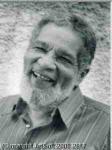Herbert Gentry
Herbert Gentry
Place: Pittsburgh
Born: 1919
Death: 2003
Biography:
Herbert Alexander Gentry, popularly known as Herb Gentry as a permanent resident of the Hotel Chelsea.
Gentry's paintings juxtapose faces and masks, shifting orientations of figures and heads—human and animal—into profiles, to the left, to the right, above and below. The direction of the head, as face or profile, leading right or left, or facing front, is played against the relative scale of each head, its position on the canvas, and in relationship to the others.
The faces evoke subtle expressions and moods. Rather than using images to depict a concrete story, Gentry releases his experiences upon the canvas. The act of spontaneous painting uses consciousness itself, and each painting reveals the self. When asked about direct influences, he avoids imposing external meanings upon primary experience, describing instead his creative process.
Philosophically near the jazz musician, Gentry breathes rhythms into a personally inflected expressionism. "The staccato beat of jazz is fused with biomorphic form in paintings which never become totally abstract, but hold the picture plane in the Cubist tradition," wrote art historian Peter Selz (1994) about Gentry's work. Gentry creates a foil for feelings and for emotion, and orchestrates his subjective figuration in dialogue with the immediacy of the painted gesture. Romare Bearden (1981) wrote that Gentry's "method is conceptual rather than realistic. One senses in the chromatic emotionalism, and in the biomorphic forms of the figures that often appear in Gentry's paintings, the strong pull of the unconscious."
Herbert Alexander Gentry was born in Pittsburgh, Pennsylvania, on July 17, 1919. He was the son of James Jentry of Madison Courthouse, Virginia, and Violet Howden of Kingston, Jamaica. By 1924 Gentry was living in Harlem, New York City, with his mother and her family.
The Harlem Renaissance provided the backdrop for Gentry's childhood. His mother worked as a dancer and actress. Under the name Teresa Gentry, she danced in the chorus with Josephine Baker and Bessye Buchanen. Later, she was in the cast of the original rendition of the Ziegfeld musical Show Boat in 1927, as well as its revival in 1932. His mother's friends included Langston Hughes, Paul Robeson and Duke Ellington.
As a youngster Gentry had a role in the play Scarlet Sister Mary, which toured the country with actress Ethel Barrymore and opened on Broadway in 1931. Gentry took inspiration from artists, musicians, writers, dancers, and actors, all of whom reinforced his belief in the creative world that lay beyond Harlem.
Educated in the New York City public schools, Gentry attended Cooper Junior High and George Washington High School. He pursued drawing in school took art classes at the Harlem YMCA and later studied art as part of the under the Federal Art Project of the WPA (Works Progress Administration) at Roosevelt High School.
In 1939, the leadership of Harlem protest demonstrations against employment discrimination is said to have included besides Rev. Adam Clayton Powell, Jr. Gentry's older cousin Arnold P. Johnson. Protester Gentry, who was studying business at New York University, is said to have been Consolidated Edison New York's first Black employee in a white-collar position and to have tolerated being told by company directors to the effect that, "If you do well, we'll hire others."
He served in the U.S. Army (1942–45), serving in the 90th Coast Guard Artillery / Anti-Aircraft Regiment working in Special Services. His U.S. Army Service in World War II took him to different countries in the Mediterranean and Northern Europe: Morocco, Algeria, Madeline Island (Italy), Corsica, Marseilles, Paris, Alsace-Lorraine (France), and Salzburg (Austria). At the end of the war, Gentry was stationed in the Paris suburb of Crepy-en-Vallois. He took every opportunity to visit Paris.
The center of the Art World before World War II, Paris still held that title in 1946. Paris touched other memories for ex-soldier Gentry, who as a youth had heard many of his mother's friends speak of their travel and performances in Paris. Home in Harlem after his discharge from the Army, he wanted to study art in Paris. Not waiting for the administration of the GI Bill to be organized in Paris, and warned that the basic amenities were still rationed, Gentry arrived for the Fall 1946 academic term.
His first year back in Paris, Gentry resided at the American House at the Cité Internationale Universitaire de Paris, where he met fellow American students: sculptor Kosta Alex, pianist Julian Ketcham, and writers Marc Behm and Dan Kurzman. Moving beyond student circles, he sought out author Richard Wright, who encouraged him in his art; he got to know writer James Baldwin.
More...
Wikipedia link: Click Here






